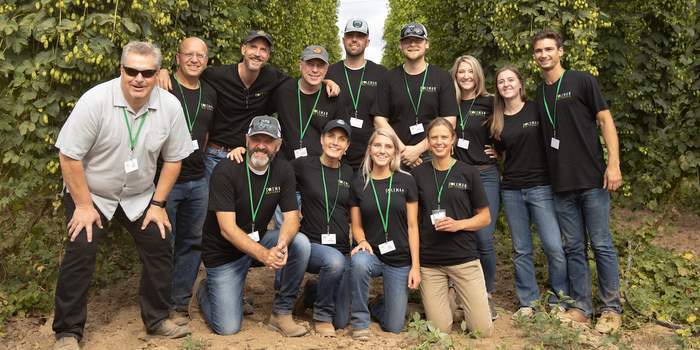Under a blue sky in a field near Corvallis, a combine spits nearly a ton of barley seeds into a bin on the back of a flatbed Ford. Pat Hayes plunges his hand into the golden kernels. This is the first time he has harvested this variety, named Alba, on such a large scale. Hayes, the head of Oregon State University’s barley breeding program, made the genetic cross that gave rise to Alba 15 years ago. He has been evaluating it in the field since. He’s hoping that the high-yielding grain will be a hit in beer, food and livestock feed.
Alba is just one of about 10,000 experimental barley varieties Hayes is growing and analyzing. He’s working hard to get a little respect for the grain and keep consumers robust and regular. Hayes touts barley as a way for farmers to diversify their crops and cash in on a growing interest in microbrews and whole-grain diets.

Barley is one of the world’s oldest cultivated crops. More than 10,000 years ago someone in the Middle East ate it, didn’t die and consequently started growing it. Its genus name comes from the word hordearii, or barley men, in reference to the Roman gladiators who grew burly eating barley. Today, however, barley is barely acknowledged even though it was the world’s fourth most-produced cereal in terms of metric tons in 2010, grown mainly for animal feed. Barley is thought of as a gummy gruel for orphans in a Dickens novel, unless you’re in Tibet, where the dietary staple is a dumpling called tsampa, a mix of barley flour, tea and yak butter.
Honey-colored fields of barley used to be a more common sight in Oregon. The state’s output peaked at 21.9 million bushels in 1957, according to the U.S. Department of Agriculture. In 2011, the state’s farmers harvested just 2.4 million bushels, earning gross sales of $10.6 million, according to a report from the OSU Extension Service, the lowest production since 1909. That same year, barley made up only 2.5 percent of all grains harvested in Oregon in terms of bushels, and it ranked 47th in gross sales among the state’s agricultural commodities.
At OSU’s Hyslop Farm near Corvallis, 10 acres of barley heads chatter in the breeze. With clipboards in hand, Hayes and his team are evaluating these thousands of different genetic crosses to see how well they resist disease, tolerate the cold and perform in the kitchen and brewery. They’re also taking note of their yields, growing some of them organically and seeing how much water and nitrogen they need.
“Craft brewers want to be able to create something that is unique, different and good so they can tell that story as part of their marketing. Consumers are looking for a locavore story and to have a beer they feel good about.” — Zach Christensen, an OSU graduate and McMinnville farmer who grows and malts barleyAfter all the measuring, weighing, malting and milling. The poking and prodding in the lab. Cold winters, soggy roots, fungal infections, insect bites. After enduring all this for years, only a handful of these varieties will make it to market. Consider that over the past 26 years, Hayes has released just 12 new varieties and germplasms. It’s not for a lack of trying: Barley breeding just takes time when you’re hand-pollinating the flowers and waiting through at least one season to see if the desired traits show up.
But Hayes is working on speeding up the process. He’s using a technique called doubled haploid production.
“By 2013, all of our new plantings here will be doubled haploids,” he says, scanning the field at Hyslop. The technique involves regenerating plants from pollen in a petri dish and creating genetically pure lines of barley in just one generation, as opposed to the six to eight years required through traditional inbreeding. The plant will produce the same barley year after year. Hayes emphasizes that this faster technique is not genetic engineering; no DNA is added, removed or modified.
Breeding new barley varieties, however, accounts for less than half of OSU’s work with the grain. For every new variety released, Hayes’ team publishes about 12 journal articles on their other research, which involves studying some of barley’s 30,000 genes. They’re trying to identify genes that allow barley to withstand low temperatures, resist disease, and survive with little water and nitrogen. They’re looking for genes responsible for malting quality, nutritional properties and flowering time. They’ve partnered on this research with countries that include Australia, Germany, Japan, Scotland and Uruguay.
Walking among the rows at OSU’s farm, Hayes points out his barleys as if they were students in his plant genetics class. They’re under so much pressure to achieve. If they don’t, they’ll never graduate from his program. There’s Streaker, a “naked,” or hull-less, food barley that resists stripe rust and was named after the campus exhibitionists of the 1970s. It’s expected to graduate in 2013. Unfortunately, it’s a bit bronzed around the arse by a fungus called scald, the common cold of barley that eats away at yield and seed size.
Next is Verdant, from the Class of 2010. It’s a high-yielder meant for livestock forage because it doesn’t have sandpapery awns — or beards as they say — that could hurt animals’ mouths. Then there’s Maja, which is getting chewed up by scald, but two shots of fungicide should clear it up, Hayes says. Alba is the tall beauty queen, the teacher’s latest pet. The screensaver image on Hayes’ computer shows his wife smiling in front of a field of it. “The woman of my life and the barley of my life,” he says.
On down the line is Charles, a variety from Idaho that has lamentably failed its midterm at OSU. The stunted plant is falling over and ravaged by disease. “You would want fungicide fed into it intravenously,” Hayes says, adding that it’s an agronomic disaster in the Willamette Valley, although it does well in drier climates.
Getting barley into beer steins is one of Hayes’ priorities. The grain is, after all, an essential ingredient in most beers. Traditionally, big brewers have wanted bland barley and relied on hops and malting for flavor, Hayes says. But barley is getting more attention thanks to an increase in small craft brewers and demand from consumers, says Zach Christensen, an OSU graduate and McMinnville farmer who grows and malts barley that he later sells to brewers.
“Craft brewers want to be able to create something that is unique, different and good so they can tell that story as part of their marketing,” says Christensen, who grows some of Hayes’ barley. “Consumers are looking for a locavore story and to have a beer they feel good about.”
With that in mind, Hayes is trying to develop barley that reflects the territory — or soil and climate — of Oregon, much like wine grapes. Additionally, he and OSU researcher Alfonso Cuesta-Marcos are seeing if genes influence the flavor of barley. They’re also breeding barleys that have desirable malting qualities. To be a malting barley, the grain has to be low in beta-glucan, a soluble fiber that impedes filtration during brewing and post-fermentation. OSU’s work has caught the attention of California’s Sierra Nevada Brewing Co. and Wisconsin’s New Glarus Brewing Co. The brewers plan to make beer from 50 to 100 exotic varieties of barley from around the world grown in 2012 by OSU. Then they’ll analyze how the beer tastes.
In addition to putting the bar back in barley, Hayes is trying to put barley back into people’s diets — sans beer bottles. He sees potential in barley because it contains beta-glucan, which has been shown to reduce cholesterol. Its low glycemic index and high fiber content make it a healthy choice for those with diabetes or who want to shed some pounds, he says.
For more information on OSU’s barley breeding program, visit barleyworld.org. The article appeared in the winter 2013 issue of OSU’s magazine, Oregon’s Agricultural Progress. To read the full article, head over to the OSU website.





RT @CraftBrewingBiz: Barley’s back: An old grain finds new prominence in craft brews. http://t.co/3TuEyi89cR #sundayreading
RT @CraftBrewingBiz: Barley’s back: An old grain finds new prominence in craft brews. http://t.co/3TuEyi89cR #sundayreading